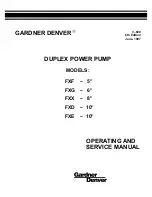
035-20401-001 Rev. A (0904)
Unitary Products Group
3
GROUND INSTALLATION
The unit may be installed at ground level on a solid base that will not
shift or settle, causing strain on the refrigerant lines and possible leaks.
Maintain the clearances shown in Figure 1 and install the unit in a level
position.
Normal operating sound levels may be objectionable if the unit is placed
directly under windows of certain rooms (bedrooms, study, etc.).
Condensate will drain from beneath the coil of the outdoor unit during
the defrost cycle. Normally this condensate may be allowed to drain
directly on the ground.
Elevate the unit sufficiently to prevent any blockage of the air entrances
by snow in areas where there will be snow accumulation. Check the
local weather bureau for the expected snow accumulation in your area.
Isolate the unit from rain gutters to avoid any possible wash out of the
foundation.
ROOF INSTALLATION
When installing units on a roof, the structure must be capable of sup-
porting the total weight of the unit, including a pad, lintels, rails, etc.,
which should be used to minimize the transmission of sound or vibra-
tion into the conditioned space.
UNIT PLACEMENT
1.
Provide a base in the pre-determined location.
2.
Remove the shipping carton and inspect for possible damage.
3.
Compressor tie-down bolts should remain tightened.
4.
Position the unit on the base provided.
NOTE:
Heat pumps will defrost periodically resulting in water drainage.
The unit should not be located where water drainage may freeze
and create a hazardous condition - such as sidewalks and
steps.
LIQUID LINE FILTER-DRIER
The heat pumps have a solid core bi-flow filter/dryer located on the liq-
uid line.
NOTE: Replacements for the liquid line drier must be exactly the same
as marked on the original factory drier. See
Source 1 for O.E.M.
replacement driers.
PIPING CONNECTIONS
The outdoor unit must be connected to the indoor coil using field sup-
plied refrigerant grade copper tubing that is internally clean and dry.
Units should be installed only with the tubing sizes for approved system
combinations as specified in Tabular Data Sheet. The charge given is
applicable for total tubing lengths up to 15 feet. See Application Data
Part Number 036-61920-001 for installing tubing of longer lengths and
elevation differences.
NOTE:
Using a larger than specified line size could result in oil return
problems. Using too small a line will result in loss of capacity
and other problems caused by insufficient refrigerant flow. Slope
horizontal vapor lines at least 1" every 20 feet toward the out-
door unit to facilitate proper oil return.
PRECAUTIONS DURING LINE INSTALLATION
1.
Install the lines with as few bends as possible. Care must be taken
not to damage the couplings or kink the tubing. Use clean hard
drawn copper tubing where no appreciable amount of bending
around obstruction is necessary. If soft copper must be used, care
must be taken to avoid sharp bends which may cause a restriction.
2.
The lines should be installed so that they will not obstruct service
access to the coil, air handling system or filter.
3.
Care must also be taken to isolate the refrigerant lines to minimize
noise transmission from the equipment to the structure.
4.
The vapor line must be insulated with a minimum of 1/2" foam rub-
ber insulation (Armaflex or equivalent). Liquid lines that will be
exposed to direct sunlight and/or high temperatures must also be
insulated.
Tape and suspend the refrigerant lines as shown. DO NOT allow tube
metal-to-metal contact. See Figure 2.
5.
Use PVC piping as a conduit for all underground installations as
shown in Figure 3. Buried lines should be kept as short as possible
to minimize the build up of liquid refrigerant in the vapor line during
long periods of shutdown
6.
Pack fiberglass insulation and a sealing material such as perma-
gum around refrigerant lines where they penetrate a wall to reduce
vibration and to retain some flexibility.
7.
See Form 690.01-AD1V for additional piping information.
The outdoor unit should not be installed in an area where mud or
ice could cause personal injury. Remember that condensate will
drip from the unit coil during heat and defrost cycles and that this
condensate will freeze when the temperature of the outdoor air is
below 32°F.
Failure to do so or using a substitute drier or a granular type may
result in damage to the equipment.
R-410A / R-22
Filter-Drier
Source 1 Part No.
Apply with Models
YZE / HC5B / HL5B
026 - 25512 - 000
All Sizes
This system uses R-410A refrigerant which operates at higher pres-
sures than R-22. No other refrigerant may be used in this system.
Gauge sets, hoses, refrigerant containers, and recovery system
must be designed to handle R-410A. If you are unsure, consult the
equipment manufacturer.
Never install a suction-line filter drier in the liquid line of an R-410A
system. Failure to follow this warning can cause a fire, injury or
death.
FIGURE 2:
Tubing Hanger
Liquid
Line
Incorrect
Correct
Tape
Sheet Metal Hanger
Insulated Vapor Line




































